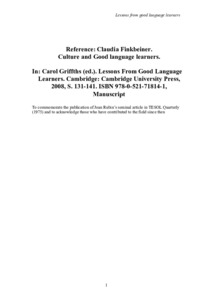| dc.date.accessioned | 2021-03-16T15:41:29Z | |
| dc.date.available | 2021-03-16T15:41:29Z | |
| dc.date.issued | 2008 | |
| dc.identifier | doi:10.17170/kobra-202102043122 | |
| dc.identifier.uri | http://hdl.handle.net/123456789/12644 | |
| dc.description | This article has been published in a revised form in "Lessons from good language learners" at https://www.cambridge.org/de/cambridgeenglish/catalog/teacher-training-development-and-research/lessons-good-language-learners?format=PB&isbn=9780521718141.
This version is published under a Creative Commons CC-BY-NC-ND. No commercial re-distribution or re-use allowed. Derivative works cannot be distributed. © copyright holder. | ger |
| dc.language.iso | eng | eng |
| dc.publisher | Cambridge University Press | |
| dc.rights | Attribution-NonCommercial-NoDerivatives 4.0 International | * |
| dc.rights.uri | http://creativecommons.org/licenses/by-nc-nd/4.0/ | * |
| dc.subject.ddc | 420 | |
| dc.title | Culture and good language learners | eng |
| dc.type | Teil eines Buches | |
| dcterms.abstract | This chapter will discuss the role of culture and language learning in the classroom. Variations in cultural, ethnic, and national characteristics within and among individual students affect classroom dynamics and therefore influence the decisions which teachers need to make in order to provide an optimal learning environment for all learners. Culture is not an easy concept to define, and is especially difficult to disentangle from concepts such as ethnicity and nationality. Individuals define and interpret these terms differently depending on the socio-cultural context they are situated in (Lantolf, 2000). There may be differences of the perceptions of self and others within a given socio-cultural context (Finkbeiner, 2006; Kramsch, 1993, 1998), while surface phenomena (such as skin colour) are often mistakenly related to categories such as ethnic, national or cultural belonging. Very frequently these categories are outdated and neither reflect “current racial/ethnic realities” (Kramsch, 1998, p.44) nor linguistic and cultural truths. In our globalizing world we cannot just glance at the surface and assume we understand others. We need to dive deep not only to understand others but also ourselves (Schmidt & Finkbeiner, 2006a, 2006b). | eng |
| dcterms.accessRights | open access | |
| dcterms.creator | Finkbeiner, Claudia | |
| dc.publisher.place | Cambridge | |
| dc.subject.swd | Fremdsprachenlernen | ger |
| dc.subject.swd | Fremdsprachenunterricht | ger |
| dc.subject.swd | Vielfalt | ger |
| dc.type.version | acceptedVersion | |
| dcterms.source.collection | Lessons from good language learners | eng |
| dcterms.source.editor | Griffiths, Carol | |
| dcterms.source.identifier | ISBN 978-0-52-171814-1 (paperback) | |
| dcterms.source.identifier | ISBN 978-0-52-188963-6 (hardback) | |
| dcterms.source.pageinfo | 131-141 | |
| dcterms.source.series | Language Teaching Library | eng |
| kup.iskup | false | |


